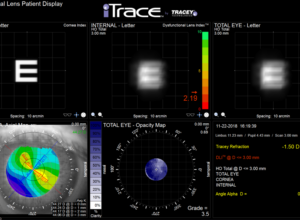

Contrast sensitivity measures the total visual system quality in terms of contrast, whereas wavefront aberrometry measures the optical quality in terms of spatial distortion. Contrast sensitivity measurement is compared with wavefront aberrometry.
#Itrace posterior corneal aberrations software
Digital-image-processing software uses contrast sensitivity data to process images to help understand the quality of what the patient sees. Increased sensitivity of linear sine-wave gratings over proposed bull's-eye radial gratings is discussed. promise rapid advances of understanding and quantifying visual quality and function by unifying clinical results reported using contrast sensitivity. New American National Standards Institute standards for contrast sensitivity based on linear sine-wave gratings are discussed that.

#Itrace posterior corneal aberrations update
This review provides an update of recent advances in understanding the quality and functional significance of contrast sensitivity for the clinician regarding cataract, intraocular lenses and refractive surgery that goes beyond the measurement of visual acuity. Moreover, systemic analysis of each toric calculator in conjunction with postoperative data is required. To achieve the best refractive outcome after toric IOL implantation, understanding the differences in keratometric values between instruments and in calculated astigmatic power among toric calculator programs is necessary. With the higher calculated astigmatic power values, the values from the iTrace toric calculator using keratometric values obtained from iTrace ray tracing wavefront aberrometry or iTrace simulated keratometry showed fair to moderate agreement with those from the other calculator-keratometry pairs in both groups. With the higher astigmatism and keratometric values from the IOLMaster, in both groups, calculations from the AcrySof and TECNIS calculators resulted in higher calculated astigmatic powers than those from same calculators with autokeratometry-measured values, demonstrating good agreement. The TECNIS calculator tended to suggest a higher astigmatic power of the toric IOL than the AcrySof calculator. Based on measured keratometric values, the astigmatic power of each toric IOL was calculated using three toric calculators.īland-Altman plots showed good agreement between six pairwise corneal astigmatism values in both groups. autokeratometry, an IOLMaster, and an iTrace, which incorporated corneal topography and ray-tracing aberrometry. To compare the astigmatic power of toric intraocular lenses (IOLs) obtained from the AcrySof, TECNIS, and iTrace toric calculator in patients with preoperative with-the-rule (WTR) or against-the-rule (ATR) corneal astigmatism.įifty eyes with cataract and corneal astigmatism greater than 0.75 diopters were enrolled in each group (WTR and ATR). Thus, the tear film can impact repeatability of an instrument and it is important to assess the tear film prior to imaging patients, which can change the way we interpret and image these patients. Pentacam wave had better repeatability in eyes with a poor tear film as compared to iTrace. Tear optics affected repeatability of Pentacam wave and iTrace. Maximum variation was seen with HOA and minimum with LOA. In eyes with OSI ≥1, the repeatability with Pentacam AXL wave dropped with ICC ranging from 0.77 for HOA, to 0.84 for LOA with lower Sw, TRT, and COV of all aberration measurements as compared to iTrace.

The Sw, TRT, and COV of all aberration measurements were significantly lower (better) than those of iTrace. All measurements with Pentacam AXL wave with OSI < 1 had excellent repeatability, intraclass correlation coefficient (ICC) ranging from 0.88 for HOA, to 0.92 for LOA. OSI showed an inverse association with TBUT (P < 0.001). Repeatability of Pentacam AXL wave and iTrace in healthy and postrefractive eyes (OSI >1 vs OSI <1) was studied using within-subject standard deviation (Sw) test-retest repeatability (TRT), coefficient of variation (COV). They underwent optical quality analyzer (OQAS, Visio metrics S.L, Terrassa, Spain) to assess objective scatter index (OSI), three scans each on Pentacam AXL wave (OCULUS Optikgerate Gmbh, Wetzlar, Germany), iTrace (Tracey™ Technologies, Texas, USA) for flat, steep keratometry, thinnest corneal thickness, root mean square higher-order aberrations (RMS HOA), RMS lower-order aberrations (LOA), spherical aberrations, RMS COMA. One hundred healthy and 100 postrefractive surgery eyes underwent dry eye evaluation including Schirmer's test and tear film break-up time (TBUT). To assess impact of tear optics on repeatability of a Scheimpflug device with a Hartmann Shack aberrometer and a ray tracing aberrometer.


 0 kommentar(er)
0 kommentar(er)
